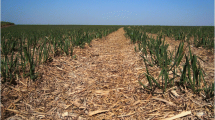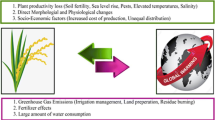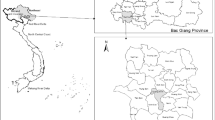Abstract
Although hybrid maize seed production is one of the most important agriculture systems worldwide, its greenhouse gas (GHG) emissions and potential mitigation measures have not been studied. In this study, we used life cycle assessment (LCA) to quantify the GHG emissions of 150 farmers run by 6 companies in an area of northwest China known for hybrid maize seed production. The results indicated that the average reactive nitrogen (Nr) losses and GHG emissions from hybrid maize seed production were 53 kg N ha−1 and 8077 kg CO2 eq ha−1, respectively. Furthermore, the average nitrogen and carbon footprints of the process were 12.2 kg N Mg−1 and 1495 kg CO2 eq Mg−1, respectively. Nitrogen fertilizer and electricity consumption for irrigation were the main contributors to high GHG emissions, accounting for 60% and 30% of the total, respectively. The GHG emissions from seed production for different companies varied greatly with their resource input. There was also a large variation in environmental burdens among the 150 farmers. Based on an analysis of the yield group, we found that the carbon footprint of the first group (the one with the highest yield) was 27% lower than the overall average. Scenario analysis suggests that a combined reduction of N input rate, optimizing irrigation, and increasing yield can eventually mitigate the carbon footprint of hybrid maize seed production by 37%. An integrated systematic approach (e.g., ISSM: integrated soil-crop system management) can reduce the GHG emissions involved in producing hybrid maize seeds. This study provides quantitative evidence and a potential strategy for GHG emissions reduction of hybrid maize seed production.





Similar content being viewed by others
Availability of data and materials
All data generated or analyzed during this study are included in this published article and its supplementary information files.
References
Agustin EF, Jon IL, Mark EW, Lahcen G, David LD Jr (2004) Simulating potential kernel production in maize hybrid seed fields. Crop Sci 44:1696–1709. https://doi.org/10.2135/cropsci2004.1696
Balafoutis A, Beck B, Fountas S, Vangeyte J, Wal, Soto I, Gómez-Barbero M, Barnes A, Eory V TVD (2017) Precision agriculture technologies positively contributing to GHG emissions mitigation, farm productivity and economics. Sustainability 9:1339. https://doi.org/10.3390/su9081339
Burney JA, Davis SJ, Lobell DB (2010) Greenhouse gas mitigation by agricultural intensification. Proc Natl Acad Sci USA 107:12052-12057. https://www.pnas.org/cgi/doi/10.1073/pnas.0914216107
Chen X, Cui Z, Vitousek PM, Cassman KG, Matson PA, Bai JS, Meng Q, Hou P, Yue S, Romheld V, Zhang F (2011) Integrated soil-crop system management for food security. Proc Natl Acad Sci USA 108:6399–6404. https://www.pnas.org/cgi/doi/10.1073/pnas.1101419108
Chen X, Cui Z, Fan M, Vitousek P, Zhao M, Ma W, Wang Z, Zhang W, Yan X, Yang J, Deng X, Gao Q, Zhang Q, Guo S, Ren J, Li S, Ye Y, Wang Z, Huang J, Tang Q, Sun Y, Peng X, Zhang J, He M, Zhu Y, Xue J, Wang G, Wu L, An N, Wu L, Ma L, Zhang W, Zhang F (2014) Producing more grain with lower environmental costs. Nature 514:486–489. https://doi.org/10.1038/nature13609
Chen Z, Xu C, Ji L, Feng J, Li F, Zhou X, Fang F (2020) Effects of multi-cropping system on temporal and spatial distribution of carbon and nitrogen footprint of major crops in China. Glob Ecol and Conserv 22:e00895. https://doi.org/10.1016/j.gecco.2019.e00895
Cui Z, Yue S, Wang G, Meng Q, Wu L, Yang Z, Zhang Q, Li S, Zhang F, Chen X (2013) Closing the yield gap could reduce projected greenhouse gas emissions: a case study of maize production in China. Global Change Biol 19:2467–2477. https://doi.org/10.2134/agronj2012.0398
Cui Z, Zhang H, Chen X, Zhang C, Ma W, Huang C, Zhang W, Mi G, Miao Y, Li X, Gao Q, Yang J, Wang Z, Ye Y, Guo S, Lu J, Huang J, Lv S, Sun Y, Liu Y, Peng X, Ren J, Li S, Deng X, Shi X, Zhang Q, Yang Z, Tang L, Wei C, Jia L, Zhang J, He M, Tong Y, Tang Q, Zhong X, Liu Z, Cao N, Kou C, Ying H, Yin Y, Jiao X, Zhang Q, Fan M, Jiang R, Zhang F, Dou Z (2018) Pursuing sustainable productivity with millions of smallholder farmers. Nature 555:363–366. https://doi.org/10.1038/nature25785
Fantin V, Righi S, Rondini I, Masoni P (2017) Environmental assessment of wheat and maize production in an Italian farmers’ cooperative. J Clean Prod 140:631–643. https://doi.org/10.1016/j.jclepro.2016.06.136
FAO, Food and Agriculture Organization of the United Nations (2020) Global Crops and livestock products in Food and Agriculture Organization of the United Nations statistical database. Available at: http://faostat.fao.org/. Accessed 30 Dec 2020
Forte A, Fiorentino N, Fagnano M, Fierro A (2017) Mitigation impact of minimum tillage on CO2 and N2O emissions from a Mediterranean maize cropped soil under low-water input management. Soil Till Res 166:167–178. https://doi.org/10.1016/j.still.2016.09.014
Gan Y, Liang C, Hamel C, Cutforth H, Wang H (2011) Strategies for reducing the carbon footprint of field crops for semiarid areas. Rev Agron Sustain Dev 31:643–656. https://doi.org/10.1007/s13593-011-0011-7
Gao J, Yan Y, Hou X, Liu X, Zhang Y, Huang S, Wang P (2020) Vertical distribution and seasonal variation of soil moisture after drip-irrigation affects greenhouse gas emissions and maize production during the growth season. Sci Total Environ. https://doi.org/10.1016/j.scitotenv.2020.142965
Grassini P, Cassman K (2012) High-yield maize with large net energy yield and small global warming intensity. Proc Natl Acad Sci USA 109:1074–1079. https://www.pnas.org/cgi/doi/10.1073/pnas.1116364109
Guardia G, Aguilera E, Vallejo A, Sanz-Cobena A, Alonso-Ayuso M, Quemada M (2019) Effective climate change mitigation through cover cropping and integrated fertilization: a global warming potential assessment from a 10-year field experiment. J Clean Prod 241:118307. https://doi.org/10.1016/j.jclepro.2019.118307
Guo J, Wang Y, Blaylock AD, Chen X (2017) Mixture of controlled release and normal urea to optimize nitrogen management for high-yielding (>15 Mg ha-1) maize. Field Crop Res 204:23–30. https://doi.org/10.1016/j.fcr.2016.12.021
Hennecke AM, Mueller Lindenlauf M, García CA, Fuentes A, Riegelhaupt E, Hellweg S (2016) Optimizing the water, carbon, and land-use footprint of bioenergy production in Mexico - Six case studies and the nationwide implications. Biofuels Bioprod Bioref 10:222–239. https://doi.org/10.1002/bbb
Hernández J, Pardo S (2019) Irrigation energy use and related greenhouse gas emissions of maize production in Mexico. Int J Water Resour D 35:701–723. https://doi.org/10.1080/07900627.2018.1482739
Hillier J, Hawes C, Squire G, Hilton A, Wale S, Smith P (2009) The carbon footprints of food crop production. Int J Agr Sustain 7:107–118. https://doi.org/10.3763/ijas.2009.0419
Hoffman E, Cavigelli MA, Camargo G, Ryan M, Ackroyd VJ, Richard TL, Mirsky S (2018) Energy use and greenhouse gas emissions in organic and conventional grain crop production: accounting for nutrient inflows. Agr Syst 162:89–96. https://doi.org/10.1016/j.agsy.2018.01.021
Hou P, Gao Q, Xie R, Li S, Meng Q, Kirkby EA, Römheld V, Müller T, Zhang F, Cui Z, Chen X (2012) Grain yields in relation to N requirement: optimizing nitrogen management for spring maize grown in China. Field Crop Res 129:1–6. https://doi.org/10.1016/j.fcr.2012.01.006
Hou P, Liu Y, Liu W, Liu G, Xie R, Wang K, Ming B, Wang Y, Zhao R, Zhang W, Wang Y, Bian S, Ren H, Zhao X, Liu P, Chang J, Zhang G, Liu J, Yuan L, Zhao H, Shi L, Zhang L, Yu L, Gao J, Yu X, Shen L, Yang S, Zhang Z, Xue J, Ma X, Wang X, Lu T, Dong B, Li G, Ma B, Li J, Deng X, Liu Y, Yang Q, Fu H, Liu X, Chen X, Huang C, Li S (2020) How to increase maize production without extra nitrogen input. Resour Conserv Recycl 160:104913. https://doi.org/10.1016/j.resconrec.2020.104913
Hussain S, Peng S, Fahad S, Khaliq A, Huang J, Cui K, Nie L (2015) Rice management interventions to mitigate greenhouse gas emissions: a review. Environ Sci Pollut Res 22:3342–3360. https://doi.org/10.1007/s11356-014-3760-4
IPCC Climate Change (2014) Impacts, adaptation and vulnerability. Part A: Global and Sectoral Aspects. (eds Field, C. B. et al.) Cambridge Univ. Press, Cambridge
Ju X, Xing G, Chen X, Zhang S, Zhang L, Liu X, Cui Z, Yin B, Christie P, Zhu Z, Zhang F (2009) Reducing environmental risk by improving N management in intensive Chinese agricultural systems. Proc Natl Acad Sci USA 106:8077–8078. https://www.pnas.org/cgi/doi/10.1073/pnas.0902655106
Juárez-Hernández S, Sheinbaum Pardo C (2019) Irrigation energy use and related greenhouse gas emissions of maize production in Mexico. Int J Water Resour D 35:701–723. https://doi.org/10.1080/07900627.2018.1482739
Kanter DR, Searchinger TD (2018) A technology-forcing approach to reduce nitrogen pollution. Nat Sustain 1:544–552. https://doi.org/10.1038/s41893-018-0143-8
Kaul J, Dass S, Manivvannan A, Singode A, Sekhar JC, Chikkappa GK (2010) Inbred Hybrid Technology in Maize-Mani. DMR Technical Bulletin 2010. Directorate of maize research, Pusa Campus, New Delhi -110 012 (India). Technical Bulletin No. 2010/1, pp.52.
Khan A, Tan D, Munsif F, Afridi M, Shah F, Wei F, Fahad S, Zhou R (2017) Nitrogen nutrition in cotton and control strategies for greenhouse gas emissions: a review. Environ Sci Pollut Res 24:23471–23487. https://doi.org/10.1007/s11356-017-0131-y
Lares-Orozco M, Robles-Morúa A, Yepez E, Handler R (2016) Global warming potential of intensive wheat production in the Yaqui Valley, Mexico: a resource for the design of localized mitigation strategies. J Clean Prod 127:522–532. https://doi.org/10.1016/j.jclepro.2016.03.128
Li S, Yan Z, Wang X, Ma S, Yan F, Zhang X, Qin J (2015) Ecological regionalization and review of maize seed production base in Hexi Corridor. Food Cash Crop Cultivation J 3:15–16. https://doi.org/10.15979/j.cnki.cn62-1057/s.2015.03.009(in Chinese)
Li Y, Li Z, Cui S, Chang SX, Jia C, Zhang Q (2019) A global synthesis of the effect of water and nitrogen input on maize (Zea mays) yield, water productivity and nitrogen use efficiency. Agr For Meteorol 268:136–145. https://doi.org/10.1016/j.agrformet.2019.01.018
Liu C, Wang K, Meng S, Zheng X, Zhou Z, Han S, Chen D, Yang Z (2011) Effects of irrigation, fertilization and crop straw management on nitrous oxide and nitric oxide emissions from a wheat-maize rotation field in northern China. Agric Ecosyst Environ 140:226–233. https://doi.org/10.1016/j.agee.2010.12.009
Ma B, Liang B, Biswas DK, Morrison MJ, McLaughlin NB (2012) The carbon footprint of maize production as affected by nitrogen fertilizer and maize-legume rotations. Nutr Cycl Agroecosyst 94:15–31. https://doi.org/10.1007/s10705-012-9522-0
MARA, Ministry of Agriculture and Rural Affairs of the People's Republic of China (2020) Notice on the establishment of national hybrid maize seed production base http://www.moa.gov.cn. Accessed 30 Dec 2020
Mueller ND, Gerber JS, Johnston M, Ray DK, Ramankutty N, Foley JA (2012) Closing yield gaps through nutrient and water management. Nature 490:254–257. https://doi.org/10.1038/nature11420
Mueller SM, Messina CD, Vyn TJ (2019) Simultaneous gains in grain yield and nitrogen efficiency over 70 years of maize genetic improvement. Sci Rep-UK 9:1–8. https://doi.org/10.1038/s41598-019-45485-5
Qin R (2014) Experiment on technology of reducing fertilizer for seed production of maize in hexi corridor of Gansu province. Agri Tech Inform 17:50–58. https://doi.org/10.15979/j.cnki.cn62-1057/s.2014.17.052(in Chinese)
Rebitzer G, Ekvall T, Frischknecht R, Hunkeler D, Norris G, Rydberg T, Schmidt WT, Suh S, Weidema BP, Pennington DW (2004) Life cycle assessment: part 1: framework, goal and scope definition, inventory analysis, and applications. Environ Int 30:701–720. https://doi.org/10.1016/j.envint.2003.11.005
Rodrigues GC, Carvalho S, Paredes P, Silva FG, Pereira LS (2010) Relating energy performance and water productivity of sprinkler irrigated maize, wheat and sunflower under limited water availability. Biosyst Eng 106:195–204. https://doi.org/10.1016/j.biosystemseng.2010.03.011
Rothausen SGSA, Conway D (2011) Greenhouse-gas emissions from energy use in the water sector. Nat Clim Change 1:210–219. https://doi.org/10.1038/NCLIMATE1147
Sainju UM, Stevens WB, Caesar-TonThat T, Liebig MA (2012) Soil greenhouse gas emissions affected by irrigation, tillage, crop rotation, and nitrogen fertilization. J Environ Qual 41:1774–1786. https://doi.org/10.2134/jeq2012.0176
Scheer C, Grace PR, Rowlings DW, Payero J (2012) Nitrous oxide emissions from irrigated wheat in Australia: impact of irrigation management. Plant Soil 359:351–362. https://doi.org/10.1007/s11104-012-1197-4
Soltani M, Soltani A, Alimagham M (2021) Ecological footprints of environmental resources for agricultural production in Iran: a model-based study. Environ Sci Pollut Res. https://doi.org/10.1007/s11356-021-15119-3
Stošić M, Ivezić V, Tadić V (2021) Tillage systems as a function of greenhouse gas (GHG) emission and fuel consumption mitigation. Environ Sci Pollut Res 28:16492–16503. https://doi.org/10.1007/s11356-020-12211-y
Tan Y, Xu C, Liu D, Wu W, Lal R, Meng F (2017) Effects of optimized N fertilization on greenhouse gas emission and crop production in the North China Plain. Field Crop Res 205:135–146. https://doi.org/10.1016/j.fcr.2017.01.003
Wang Y (2016) Effects of different film mulching methods on corn seed production and water use efficiency. Mode Agr Sci Tech 24:31–35 (in Chinese)
Wang X, Zou C, Zhang Y, Shi X, Liu J, Fan S, Liu Y, Du Y, Zhao Q, Tan Y, Wu C, Chen X (2018) Environmental impacts of pepper (Capsicum annuum L) production affected by nutrient management: a case study in southwest China. J Clean Prod 171:934–943. https://doi.org/10.1016/j.jclepro.2017.09.258
Yao Z, Zhang W, Wang X, Lu M, Chadwick D, Zhang Z, Chen X (2021) Carbon footprint of maize production in tropical/subtropical region: a case study of Southwest China. Environ Sci Pollut Res. https://doi.org/10.1007/s11356-021-12663-w
Zhang S, Gao P, Tong Y, Norse D, Lu Y, Powlson D (2015) Overcoming nitrogen fertilizer over-use through technical and advisory approaches: a case study from Shaanxi Province, northwest China. Agric Ecosyst Environ 209:89–99. https://doi.org/10.1016/j.agee.2015.03.002
Zhang L, Che Z, Cui Y, Cui Z, Wan L (2018) The effect of drip irrigation under different water and fertilizer condition on yield and water use efficiency of seed corn. Water Saving Irri 12:29–32 (in Chinese)
Zhang W, He X, Zhang Z, Gong S, Zhang Q, Zhang W, Liu D, Zou C, Chen X (2018b) Carbon footprint assessment for irrigated and rainfed maize (Zea mays L.) production on the Loess Plateau of China. Biosyst Eng 167:75–86. https://doi.org/10.1016/j.biosystemseng.2017.12.008
Zhao Y, Yu A, Li R (2013) The effect of mulching method on yield, water use efficiency and irrigation efficiency of seed Maize in Oasis Irrigation Area. Water Saving Irri 5:15–21. https://doi.org/10.3969/j.issn.1007-4929.2013.05.005(inChinese)
Zheng L, Ja B, He H, Lin F, Jiang G, Ma F (2013) Study on water requirement and water use efficiency of mulched corn for seed water with drip irrigation. Xinjiang Agr Sci 50(11):2000–2005. https://doi.org/10.6048/j.issn.1001-4330.2013.11.006(in Chinese)
Zou X, Li Y, Li K, Cremades R, Gao Q, Wan Y, Qin X (2015) Greenhouse gas emissions from agricultural irrigation in China. Mitig Adapt Strat Gl 20:295–315. https://doi.org/10.1007/s11027-013-9492-9
Zwart SJ, Bastiaanssen WGM (2004) Review of measured crop water productivity values for irrigated wheat, rice, cotton and maize. Agr Water Manage 69:115–133. https://doi.org/10.1016/j.agwat.2004.04.007
Funding
We thank the National Key R&D Program of China (NO. 2018YFD0200700), the Fundamental Research Funds for the Central Universities (XDJK2020C069), and the Ministry of Education, China, and the China Agriculture Research System (CARS-02–15). We also thank Chongqing Special Postdoctoral Science Foundation, for their financial support.
Author information
Authors and Affiliations
Contributions
DL: investigation, methodology, data analysis, writing original draft, and editing; WZ, XW, and YG: review and editing; XC: conceptualization, writing—review and editing, supervision, and funding acquisition.
Corresponding authors
Ethics declarations
Ethics approval
Not applicable.
Consent to participate
Not applicable.
Consent for publication
Not applicable.
Competing interests
The authors declare no competing interests.
Supplementary information
Supplementary material related to this article can be found in the appendix.
Additional information
Communicated by Gangrong Shi.
Publisher's note
Springer Nature remains neutral with regard to jurisdictional claims in published maps and institutional affiliations.
Responsible Editor: Gangrong Shi
Supplementary Information
Below is the link to the electronic supplementary material.
Rights and permissions
About this article
Cite this article
Liu, D., Zhang, W., Wang, X. et al. Greenhouse gas emissions and mitigation potential of hybrid maize seed production in northwestern China. Environ Sci Pollut Res 29, 17787–17798 (2022). https://doi.org/10.1007/s11356-021-16990-w
Received:
Accepted:
Published:
Issue Date:
DOI: https://doi.org/10.1007/s11356-021-16990-w




